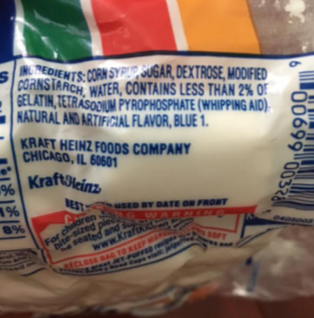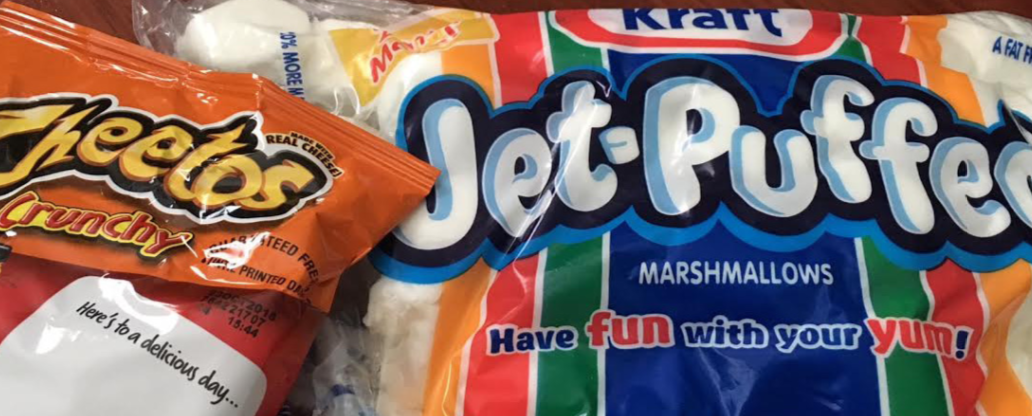By Alecia Sexton
Layout Manager
Not many of us are accustomed to read- ing food labels before we indulge in a bag of Sour Patch Kids or a cup of yogurt, and many people are uninterested in the ingredients in a McDonald’s strawberry milkshake. However, these snacks, among many other popular items in stores and at restaurants, contain a common additive that is so controversial that it’s banned in other countries such as the U.K.; food dyes.
 Odds are that if you read the ingredient list of any food item that has any coloring, you’ll find the names Red 40, Yellow 5, Blue 2, and other simple colors. They’re seemingly simple but in actuality these colors are cooked up in a laboratory, made up of many hard-to- pronounce chemicals. The Food and Drug Administration (FDA) has deemed these chemicals “safe to consume in small amounts.”
Odds are that if you read the ingredient list of any food item that has any coloring, you’ll find the names Red 40, Yellow 5, Blue 2, and other simple colors. They’re seemingly simple but in actuality these colors are cooked up in a laboratory, made up of many hard-to- pronounce chemicals. The Food and Drug Administration (FDA) has deemed these chemicals “safe to consume in small amounts.”
But just how small is small? This guideline is hard to grasp and even harder to measure since the actual amount of dye in each food product is unknown, as is the amount of dye ingested by an individual each day. Since dyes are often found in more than one consumed product, it can be almost impossible to tell.
Studies performed by the British government that have been published on the National Center for Biotechnology Information website confirm that some studies performed by the FDA regarding food dyes have been found to be inaccurate, since they’re often done on lab rats and are terminated before the animals have the physiological ability to develop disease or illness. The typical length of a funded study is two rat years which equates to about sixty five human years. Many criticize this because unless rats are administered the proportionally appropriate amount of dyes that the average person would consume in sixty five years, it cannot be deemed accurate.
Food dyes have gained a negative popular opinion based on several small scaled human studies. Dr. Warner Beteman, a member of the British government, and allergists from San Francisco, California have performed studies concluding that the artificial dyes Red 40 and Yellow 5 cause hyperactivity and exhibit geno- toxic effects on chromosomes.
Genotoxicity is when chemicals exert a mutational effect on the chromosomes of certain genetically predisposed individuals. The mutational effects observed in studies include the development of cancerous and non cancerous tumors, as well as altered nervous system development and function.
Developing children are the demographic with the greatest exposure to artificial dyes. Since early childhood is the stage of life when
the most important growth and development is occurring, it would seem that this would be the most apparent time to steer clear of food dyes. It’s been concluded in a 2004 European study that cocktails of dyes in products actually have the ability to create synergistic effects, meaning that when blended, negative physiological processes are actually accelerated. Also concluded is the fact that children with ADHD benefited in 73 percent of cases from eliminating artificial colorings, experiencing improved symptoms and decreased need for medication.
While other countries are either required to label products that contain dyes or have eliminated them completely, the U.S. still backs up the claim that dyes aren’t an issue since they’re only “present in negligible amounts.”
According to the Center for Science in the Public Interest, major companies and manufacturers such as McDonalds, Mars, Pepsi and Kraft in other countries have switched to natural dyes and food colorings from vegetables.
In the U.K., orange soda is actually colored with carrot and pumpkin extracts rather than a cocktail of yellow and red chemicals.
While more research and concrete studies are necessary in the field of food colorings, it can’t hurt to read food labels and try and control the amount of colorings consumed. You may be surprised to find that the pickles, ice cream, salmon and the salad dressing in your shopping cart are full of a rainbow of controversial colors.
Editor’s Note: The Pioneer is not responsible for giving medical advice. Please refer to a medical professional for serious concerns regarding personal health.





Be First to Comment